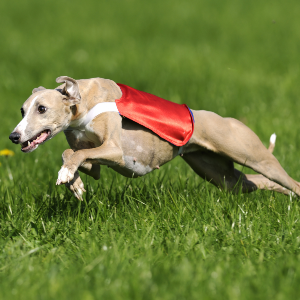
Whippet
Intelligent, quiet and friendly, Whippets make great companions as long as they get plenty of exercise. They are fairly low-maintenance, but require attention around cats and wildlife, since they have a tendency to chase after them.
Interested in discovering if your dog is a Whippet?
Check out Wisdom Panel's DNA tests.

Whippet Traits
General Appearance
The Whippet is a natural-born athlete. A picture of agile speed with the inverted S-curve of the sighthound, they look much like smaller versions of their close relatives, the Greyhound. They are a medium-sized dog with large, expressive eyes and a smoothly arched back.
Coat and Colouring
Whippets come in almost all color types and don’t have a specific color assigned to their breed. Their base color spans fawn, red, orange, tan, cream, black, and blue-gray. Markings that can also be present include brindle with black stripes, brindle with bluish stripes, black mask, blue mask, watermarking, sabling, and varying amounts of white from entirely white to just the tips of toes and tail.
You can even find Whippets with black or blue saddle blanket over a base of fawn or brindle (with or without white), although this is rare.
Distinctive Physical Traits
Carrying the typical inverted “S” of sighthounds, these dogs have a sleek and powerful look. They have a small, pointed head atop their long graceful neck. This leads to a deep chest tapering down to a slim body, supported by thin but strong legs.
Whippet Temperament
Whippets are gentle, affectionate companions. They love spending time with their human counterparts and are wonderful with children. They have a tendency to chase smaller animals, particularly if those animals are running away from them. They do well with strangers and other dogs, and they rarely bark. With the right amount of exercise they are excellent, sturdy companions.


Whippet History
In the 18th century, coal miners in northern England needed a dog that they could use for both hunting and entertainment. They couldn’t afford to feed or house large Greyhounds, so the miners bred a smaller version of this racing dog. Although it’s not known which specific breeds were used to create the Whippet, the resulting dog was the fastest of its size, able to reach speeds of 35 miles per hour.
The name Whippet comes from the term “whappet,” which means “small dog that yelps.” By the turn of the 20th century, textile workers from Lancashire began moving to New England, bringing with them their dogs, the Whippet. Popularity for the breed took off in America, where racing the breed became an instant hit. The first Whippet was registered with the AKC in 1888.
Whippet Care
Nutrition
Whippets require a high-quality dog food that is age-appropriate—whether it’s commercially manufactured or homemade (with a veterinarian’s supervision and approval). It’s important to monitor the amount of food you give your Whippet. Reduce the portions or restrict calories if your pup gains weight, as whippets can easily become overweight.
Grooming
Whippets shed less than other breeds, and their short, light coat only requires a brush once a week and an occasional bath as needed. Whippets are a very low-maintenance grooming dog.
All dogs require regular dental care, including at-home teeth brushing and professional dental cleanings, and the Whippet is no exception. Maintaining good dental hygiene is important for their overall long-term health.
Exercise
Whippets need to be exercised daily, and are natural born sprinters that love to retrieve. A mixture of intense fetch sessions and regular walks will keep them happy. They are also social and enjoy play sessions with another dog. They make great competitors in lure coursing, as well. It is important to always keep them on a lead, as they have a tendency to chase.
Training
Whippets are smart and eager to please, which makes training them relatively easy. Using positive training methods, like treats or exercise as rewards is important, as they are a very sensitive breed.

Whippet Genetic Health Conditions
-
Muscular Hypertrophy (Double Muscling)
Muscular Hypertrophy (Double Muscling) is a condition where the muscles of the body become much larger and more pronounced than normal, due to a defect in a gene that helps to regulate muscle growth.
-
Phosphofructokinase Deficiency
Phosphofructokinase Deficiency (PFK) is a disorder where an enzyme important in the production of energy from sugars is lacking, resulting in weakness, muscle cramps, discolored urine, anemia, and jaundice.
Knowing if your Whippet is a carrier or at-risk for these conditions can help you and your veterinarian plan for your pup's lifelong care. With Wisdom Panel™ Premium, you can get results for over 200 genetic health tests.
Breed Group
Sighthound
The Sighthound Group consists of some of the oldest breeds often reserved for ownership by royalty. Sleek and built for speed and stamina, they share many of the same characteristics as those in the Sporting and Hound Groups.
Resources
https://www.akc.org/dog-breeds/whippet/
https://www.americanwhippetclub.net/
https://www.royalcanin.com/us/dogs/breeds/breed-library/whippet
https://vcahospitals.com/know-your-pet/dog-breeds/whippet
http://images.akc.org/pdf/breeds/standards/Whippet.pdf
Reviewed 26 July 2020 by Cindy Elston, DVM, MPH














